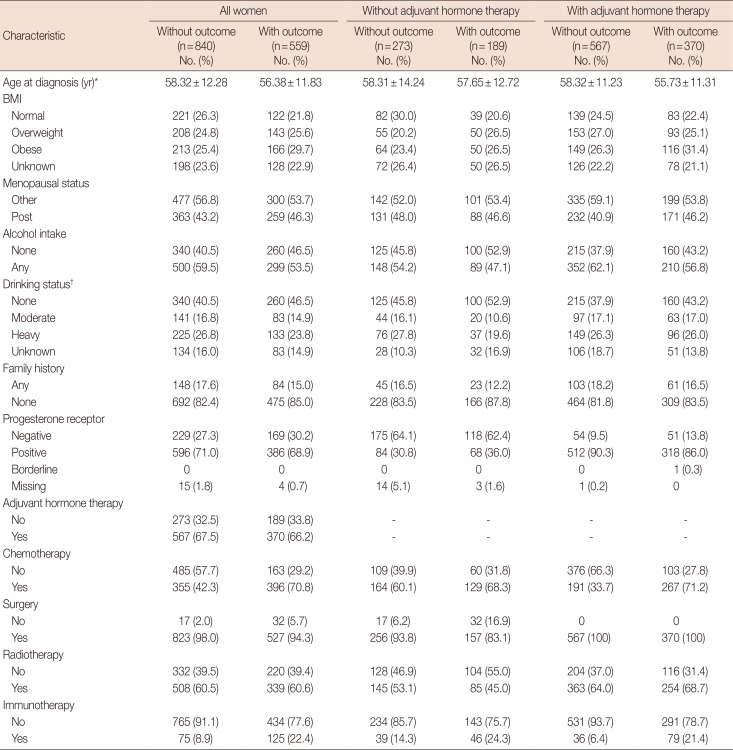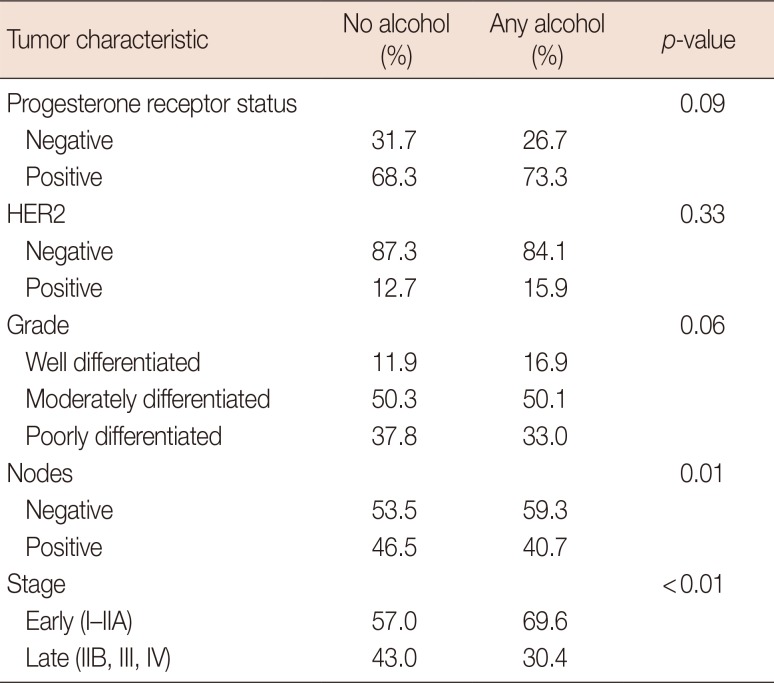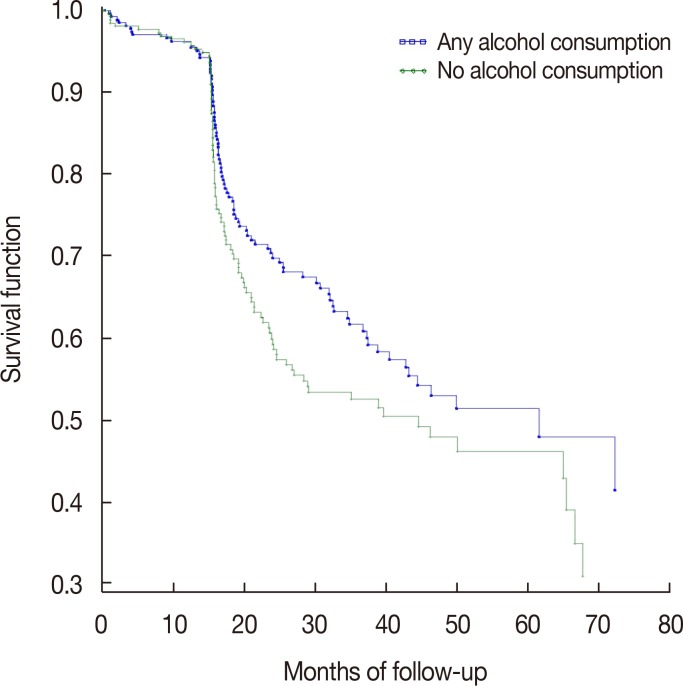1. American Cancer Society. Cancer Facts & Figures 2017. Atlanta: American Cancer Society;2017.
2. Singletary KW, Gapstur SM. Alcohol and breast cancer: review of epidemiologic and experimental evidence and potential mechanisms. JAMA. 2001; 286:2143–2151. PMID:
11694156.
3. Hamajima N, Hirose K, Tajima K, Rohan T, Calle EE, Heath CW Jr, et al. Alcohol, tobacco and breast cancer: collaborative reanalysis of individual data from 53 epidemiological studies, including 58,515 women with breast cancer and 95,067 women without the disease. Br J Cancer. 2002; 87:1234–1245. PMID:
12439712.
4. Kwan ML, Kushi LH, Weltzien E, Tam EK, Castillo A, Sweeney C, et al. Alcohol consumption and breast cancer recurrence and survival among women with early-stage breast cancer: the life after cancer epidemiology study. J Clin Oncol. 2010; 28:4410–4416. PMID:
20805458.

5. Newcomb PA, Kampman E, Trentham-Dietz A, Egan KM, Titus LJ, Baron JA, et al. Alcohol consumption before and after breast cancer diagnosis: associations with survival from breast cancer, cardiovascular disease, and other causes. J Clin Oncol. 2013; 31:1939–1946. PMID:
23569314.

6. Kwan ML, Chen WY, Flatt SW, Weltzien EK, Nechuta SJ, Poole EM, et al. Postdiagnosis alcohol consumption and breast cancer prognosis in the after breast cancer pooling project. Cancer Epidemiol Biomarkers Prev. 2013; 22:32–41. PMID:
23150063.

7. Reding KW, Daling JR, Doody DR, O'Brien CA, Porter PL, Malone KE. Effect of prediagnostic alcohol consumption on survival after breast cancer in young women. Cancer Epidemiol Biomarkers Prev. 2008; 17:1988–1996. PMID:
18664549.

8. Clarke M. Meta-analyses of adjuvant therapies for women with early breast cancer: the Early Breast Cancer Trialists' Collaborative Group overview. Ann Oncol. 2006; 17(Suppl 10):x59–x62. PMID:
17018753.

9. Horn-Ross PL, Canchola AJ, Bernstein L, Clarke CA, Lacey JV Jr, Neuhausen SL, et al. Alcohol consumption and breast cancer risk among postmenopausal women following the cessation of hormone therapy use: the California Teachers Study. Cancer Epidemiol Biomarkers Prev. 2012; 21:2006–2013. PMID:
22832206.

10. Purohit V. Can alcohol promote aromatization of androgens to estrogens? A review. Alcohol. 2000; 22:123–127. PMID:
11163119.

11. Kim SK, Novak RF. The role of intracellular signaling in insulin-mediated regulation of drug metabolizing enzyme gene and protein expression. Pharmacol Ther. 2007; 113:88–120. PMID:
17097148.

12. Meskar A, Plee-Gautier E, Amet Y, Berthou F, Lucas D. Alcohol-xenobiotic interactions: role of cytochrome P450 2E1. Pathol Biol (Paris). 2001; 49:696–702. PMID:
11762131.
13. Klein DJ, Thorn CF, Desta Z, Flockhart DA, Altman RB, Klein TE. PharmGKB summary: tamoxifen pathway, pharmacokinetics. Pharmacogenet Genomics. 2013; 23:643–647. PMID:
23962908.
14. Weathermon R, Crabb DW. Alcohol and medication interactions. Alcohol Res Health. 1999; 23:40–54. PMID:
10890797.
15. Hassett MJ, Ritzwoller DP, Taback N, Carroll N, Cronin AM, Ting GV, et al. Validating billing/encounter codes as indicators of lung, colorectal, breast, and prostate cancer recurrence using 2 large contemporary cohorts. Med Care. 2014; 52:e65–e73. PMID:
23222531.

16. U.S. Department of Health and Human Services. U.S. Department of Agriculture. Dietary Guidelines for Americans, 2005. 6th ed. Washington, DC: U.S. Government Printing Office;2005.
17. Gnerlich JL, Deshpande AD, Jeffe DB, Sweet A, White N, Margenthaler JA. Elevated breast cancer mortality in women younger than age 40 years compared with older women is attributed to poorer survival in early-stage disease. J Am Coll Surg. 2009; 208:341–347. PMID:
19317994.

18. Chan DS, Vieira AR, Aune D, Bandera EV, Greenwood DC, McTiernan A, et al. Body mass index and survival in women with breast cancer-systematic literature review and meta-analysis of 82 follow-up studies. Ann Oncol. 2014; 25:1901–1914. PMID:
24769692.

19. Therneau TM, Grambsch PM. Modeling Survival Data: Extending the Cox Model. New York: Springer;2000. p. 140–152.
20. Flatt SW, Thomson CA, Gold EB, Natarajan L, Rock CL, Al-Delaimy WK, et al. Low to moderate alcohol intake is not associated with increased mortality after breast cancer. Cancer Epidemiol Biomarkers Prev. 2010; 19:681–688. PMID:
20160253.

21. Vrieling A, Buck K, Heinz J, Obi N, Benner A, Flesch-Janys D, et al. Prediagnostic alcohol consumption and postmenopausal breast cancer survival: a prospective patient cohort study. Breast Cancer Res Treat. 2012; 136:195–207. PMID:
22961011.

22. Trentham-Dietz A, Newcomb PA, Nichols HB, Hampton JM. Breast cancer risk factors and second primary malignancies among women with breast cancer. Breast Cancer Res Treat. 2007; 105:195–207. PMID:
17186360.

23. Allemani C, Berrino F, Krogh V, Sieri S, Pupa SM, Tagliabue E, et al. Do pre-diagnostic drinking habits influence breast cancer survival? Tumori. 2011; 97:142–148. PMID:
21617706.

24. Din N, Allen IE, Satariano WA, Demb J, Braithwaite D. Alcohol consumption and mortality after breast cancer diagnosis: the health and functioning in women study. Breast Dis. 2016; 36:77–89. PMID:
27662274.

25. Woods RW, Oliphant L, Shinki K, Page D, Shavlik J, Burnside E. Validation of results from knowledge discovery: mass density as a predictor of breast cancer. J Digit Imaging. 2010; 23:554–561. PMID:
19760292.

26. Lowry SJ, Kapphahn K, Chlebowski R, Li CI. Alcohol use and breast cancer survival among participants in the women's health initiative. Cancer Epidemiol Biomarkers Prev. 2016; 25:1268–1273. PMID:
27197280.

27. Dumitrescu RG, Shields PG. The etiology of alcohol-induced breast cancer. Alcohol. 2005; 35:213–225. PMID:
16054983.

28. Del Boca FK, Darkes J. The validity of self-reports of alcohol consumption: state of the science and challenges for research. Addiction. 2003; 98(Suppl 2):1–12.

29. Feunekes GI, van't Veer P, van Staveren WA, Kok FJ. Alcohol intake assessment: the sober facts. Am J Epidemiol. 1999; 150:105–112. PMID:
10400547.

30. Giovannucci E, Colditz G, Stampfer MJ, Rimm EB, Litin L, Sampson L, et al. The assessment of alcohol consumption by a simple self-administered questionnaire. Am J Epidemiol. 1991; 133:810–817. PMID:
2021148.







 PDF
PDF ePub
ePub Citation
Citation Print
Print



 XML Download
XML Download